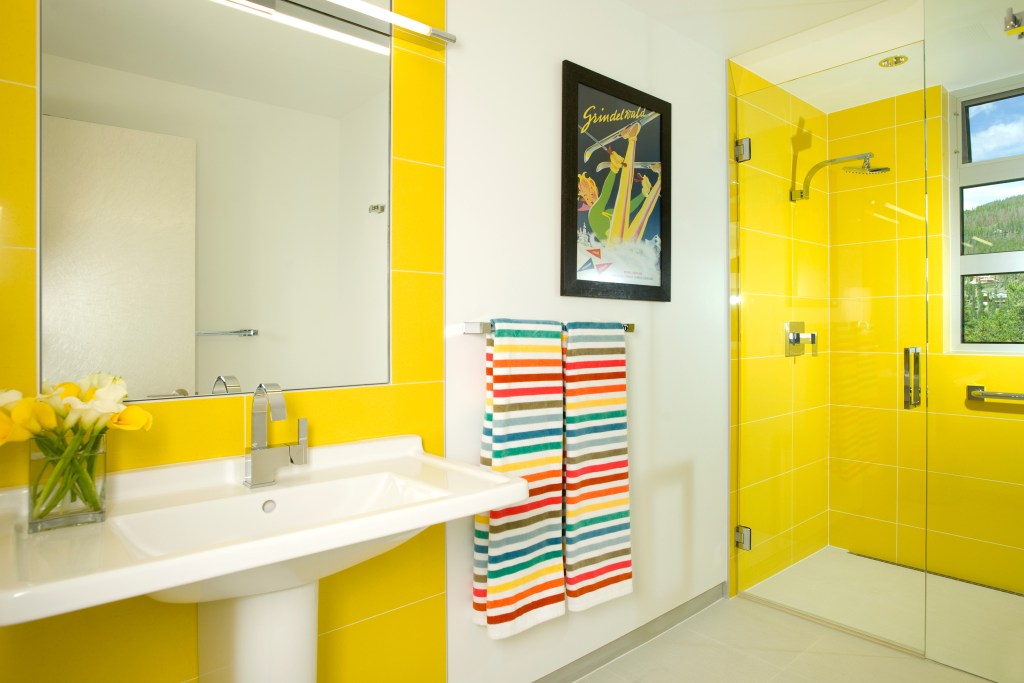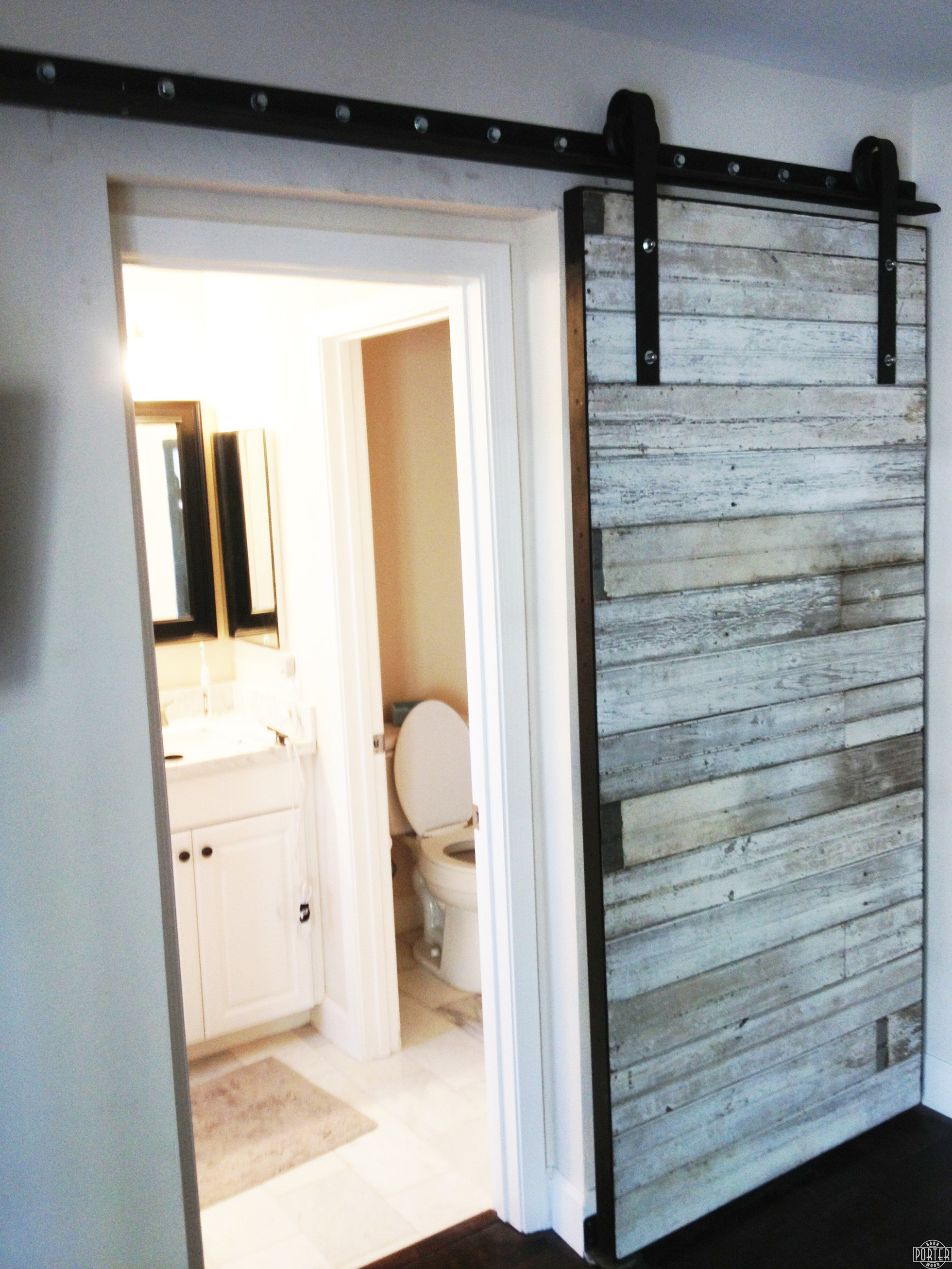For style, sanctuary, and ROI, you can’t go wrong with these bathroom design ideas.

- All those pretty photos on all those pretty home design websites are fun to click through — and maddening when it comes time to make bathroom remodeling decisions. Too many choices.
- We’ve got your back: We distilled all the visual noise down to the essence of what makes a bathroom remodel truly great.
With the “Remodeling Impact Report” from the National Assocation of REALTORS® pegging the national median cost of a bathroom remodel at $30,000, you’ll want to make sure you get maximum comfort, convenience, enjoyment — and resale juice when the time comes to sell.
Here’s the definitive list of practical (and hedonistic) features.
#1 Heated Ceramic Tile Flooring

- Enduring, waterproof, and good-looking, ceramic tile bathroom flooring is the classic, never-out-of-style surface material for any bathroom. Plus, consumers (read: future buyers) love it: In a survey from the National Kitchen and Bath Association (NKBA), 83% of respondents said ceramic tile was their No. 1 choice for bathroom flooring.
- With prices ranging from a mere $1 per square foot to $20 and more, you’ll find a huge array of choices, styles, and colors that’ll work with any budget.
- But ceramic tile can chill your tootsies. Pair your ceramic with thin electric radiant mats that go under the tile without raising the floor level — ideal for retrofit installations.
- A typical system uses about the same amount of electricity as three 100-watt incandescent light bulbs. Plus, radiant heat is often more efficient than forced-air heating because it eliminates heat loss through the ducts, says the U.S. Department of Energy. It also distributes heat uniformly across the floor, taking less time to warm a room than other types of heat.
- At $5 to $15 per square foot to install, radiant mats are as easy on the budget as they are on the sole.
- Nice-to-have ceramic tile accompaniments:
- No-slip ceramic tile. With its finely textured surface, it’s great for traction, making it an exceptionally safe bathroom flooring for young kids or folks with limited mobility.
- Look for one of two ratings on the packaging.
- A COF (coefficient of friction) standard of .60 or greater means the tile is rated as non-slip when wet by the Ceramic Tile Institute.
- The DCOF (dynamic coefficient of friction) AcuTest measurement, the new gold standard now coming on the market, requires a value of .42 or above for non-slip tile.
Tip: No-slip tile’s texture can trap dirt, and that requires extra elbow grease to clean.
Epoxy grout. New formulas resist staining and discoloration over time better than traditional ones. They’re also more flexible than regular grout and less prone to cracking, making them ideal for flooring installations.
The key to grouting success is the installer. Make sure your contractor is familiar with epoxy grouts, which require finesse to shape and handle. You’ll pay an extra $50 to $100 to cover a 6-foot-by-12-foot bathroom floor with epoxy, according to the Tile Council of North America.
Programmable radiant heat thermostat. Want to treat yourself extra nice? Greet the day with a sigh of relief when you add a wall-mounted programmable thermostat (about $60 to $200) that’ll start warming up your floors whenever you want. How about a half an hour before your alarm goes off?Popular Reads
#2 Curbless Walk-in Shower

- More than 60% of respondents to a recent survey by the American Institute of Architects said walk-in, curbless showers are increasing in popularity. For good reason: They’re stylish, safe for folks of all ages, and oh so easy to clean.
- They dovetail nicely with ceramic tile floors, too. You can have one continuous surface that moves seamlessly from shower to the main bath area.
- Plus, they’re all about marketability. As the population ages, a contemporary walk-in is a selling point.
- Be sure to hire a remodeling contractor with experience. Making a curbless shower takes know-how — the shower floor has to slope to the drain hole, which means the new drain will be located below the surface of the existing floor.
- To make that work, you’ll have to remove old flooring and subflooring and alter the framing underneath the floor. It’s a good idea to consult with your local building authorities beforehand so that the work will be up to code and pass inspection.
- Related: Dump Your Tub for a Dreamy Shower
#3 Quartz Countertop

- We love natural stone, but in this battleground of soaps, lotions, pastes, and poultices, we prefer the impervious beauty of synthetic, low-VOC quartz.
- “Consumer Reports” testing gives the edge to quartz over granite, citing quartz’s ability to resist stains and abrasions. It’ll look good year after year. Plus, the surface is so impervious bacteria can’t lodge in it.
- Quartz countertop material is a synthetic composite made up of about 90% quartz particles held together with binders. It’s virtually maintenance-free — it never needs to be sealed — and comes in dozens of styles and colors. If you’re stuck on the idea of stone, many quartz versions mimic the real thing.
- Quartz runs $40 to $100 per square foot, installed (about the same as granite, although some varieties of granite get very pricey).
#4 One Big Sink Instead of Two Small Ones
Togetherness is a beautiful thing, but in the master bath, you’re church and your partner’s state. Establish your individuality without losing your bond with a large (38-inch or more) sink ($350 to $1,200). One big sink saves more counter space than two, and still lets you both wash up simultaneously.
Spec an undermount sink to go with your quartz countertop — undermounts have no protruding lip and help make cleanup a snap. The perfect companion to quartz countertops, undermount lavatory sinks are the preferred choice of 87% of respondents to a 2013 survey from the NKBA, and have been for several years.
Tip: Extra-large undermount sinks may need extra support. Check the sink specs and confer with your installer before you buy.
#5 Single-Hole, Motion-Activated Faucet
Ah, the savings. “Motion-activated, touchless faucets shut off automatically so you’re not running the water continually, like when you’re brushing your teeth, which saves a significant amount of water,” says NKBA president John Petrie.
Besides that, we love the fact that sleek, single-hole touchless faucets are right in step with the calm, simple lines of transitional style. Transitional is a universally appealing, trend-defying design that’s cozy, elegant, and ensures a great return on your investment.
Finally, have you ever tried to clean around a two-handle vanity faucet with a narrow (4-inch) spread? Did you require therapy afterward? We heartily endorse the single-hole, lever-type faucet for your bathroom sink — and your sanity.
These tres-cool faucets run $200 to $650 and up. Some have temperature controls so you (or your kids) can’t get scalded.
For extra utility savings, look for faucets with the WaterSense label that use only 1.5 gallons per minute (gpm) compared with the standard 2.2 gpm flow of regular faucets.
#6 Humidity-Controlled Exhaust Fan
What’s homebuyers’ No. 1-requested bathroom feature? An exhaust fan, says a report from the National Association of Home Builders. Wow — bath fans beat out linen closets and separate tubs and showers.
A fan or an operable window in a bathroom is required by building code. But who wants to open a window in winter to get rid of excess humidity? Get a fan with a humidity-sensing on/off switch. It’ll turn on when moisture levels are high and automatically shut off when things return to normal. That keeps mold at bay, ensures you’re not sucking out air-conditioned or heated indoor air, and prevents the fan from using power long after it needs to.
Tip: Make sure your contractor vents the fan to the outside, not the attic, or you might develop mold problems aloft.
Other fan options include multiple speeds, nightlights, and manual timers; you’ll pay up to $600 for a fan with all the goodies.
#7 High-Efficiency, Dual-Flush Toilet
Saving water is our future; a high-efficiency, dual-flush toilet reduces water usage and appeals to any buyer looking for a cost-effective home.
All 25 toilets recently tested by “Consumer Reports” “removed liquid waste superbly,” including the dual-flush models. This is a change, says CR, from previous tests, when many dual-flush models performed well with solid wastes but underperformed with liquid wastes.
Tip: Bidets are standard features in Asia and Europe, but they’ve been slow to catch on in the U.S. (and there aren’t any WaterSense-labeled models). Nevertheless, some manufacturers are creating hybrid toilets and toilet seats ($650) that have bidet features, and we’re going on record as recommending them. They save lots of TP, and they appeal to our melting-pot homebuyer mix of races and cultures, a benefit when it comes time to sell.
#8 Pocket or Sliding Barn Door

- The floor area of a bathroom is precious. Why waste any with a swinging door that eats up some 14 square feet of space? A pocket door or barn door slides out of the way without requiring any clearance, leaving more room for storage and design flexibility.
- Google Trends shows that interest in sliding barn doors hovered at a lukewarm rating of about 40 from 2004 through 2011, when interest upticked to 70 before reaching an all-time high of 100 just last year — the highest possible rating on the Google interest scale.
- The sliding door phenomenon partners neatly with sustainability: old, salvaged doors of all kinds make showpiece barn doors for your bathroom.
- So pocket or barn doors? Either can work well, depending on your budget.
Our editors had a lively debate about recommending pocket doors, which disappear into the wall. Some said the typical recessed door pull for pocket doors is awkward and can pinch fingers.
Modern tech to the rescue: You can find edge-mounted pocket door hardware with a handle that pops out at the touch of a button ($121). Or, add a door stop inside the wall framing to prevent the door from sliding all the way inside the wall. That way, you can safely use a recessed pull or add a traditional handle or knob to open and shut the door.
Tearing out drywall and reframing for a pocket door is $1,000 to $3,500, depending on the complexity of the job.
You can install a barn-style door, which hangs from a track above the doorway and slides in front of a wall., for less. It’s a good DIY project. Barn door kits cost $400 to $900, but if you’re handy, buy the hardware for $100 to $500 and make your own door, or find a used door at a salvage building supply store.
#9 Calm Colors
It’s always cool to be up on trends, but we say make your bathroom an exception. It’s your sanctuary — it should be soothing and filled with light.
That doesn’t mean it has to be boring. In fact, it’s a good idea to include a painted wall surface so you can dash color about on a whim and change it just as easily. Non-permanent items, such as artwork and antique mirrors, add beaucoup personality.
But permanent surfaces — ceramic tile and fixtures — need quiet, calm neutrals. White, beige, and gray are favorites. In fact, the NKBA says gray is the trendiest color for baths these days, so you win on two fronts, for now.
“A neutral color palette really is safe, especially in terms of resale value,” says NKBA’s Petrie. “You can always be expressive with colorful towels or curtains, things that are less expensive and easier to change than more permanent features.”
Plus, lighter colors help bounce light around, helping you see what a fantastic bathroom you’ve put together.
“Visit HouseLogic.com for more articles like this. Reprinted from HouseLogic.com with permission of the NATIONAL ASSOCIATION OF REALTORS®.”
